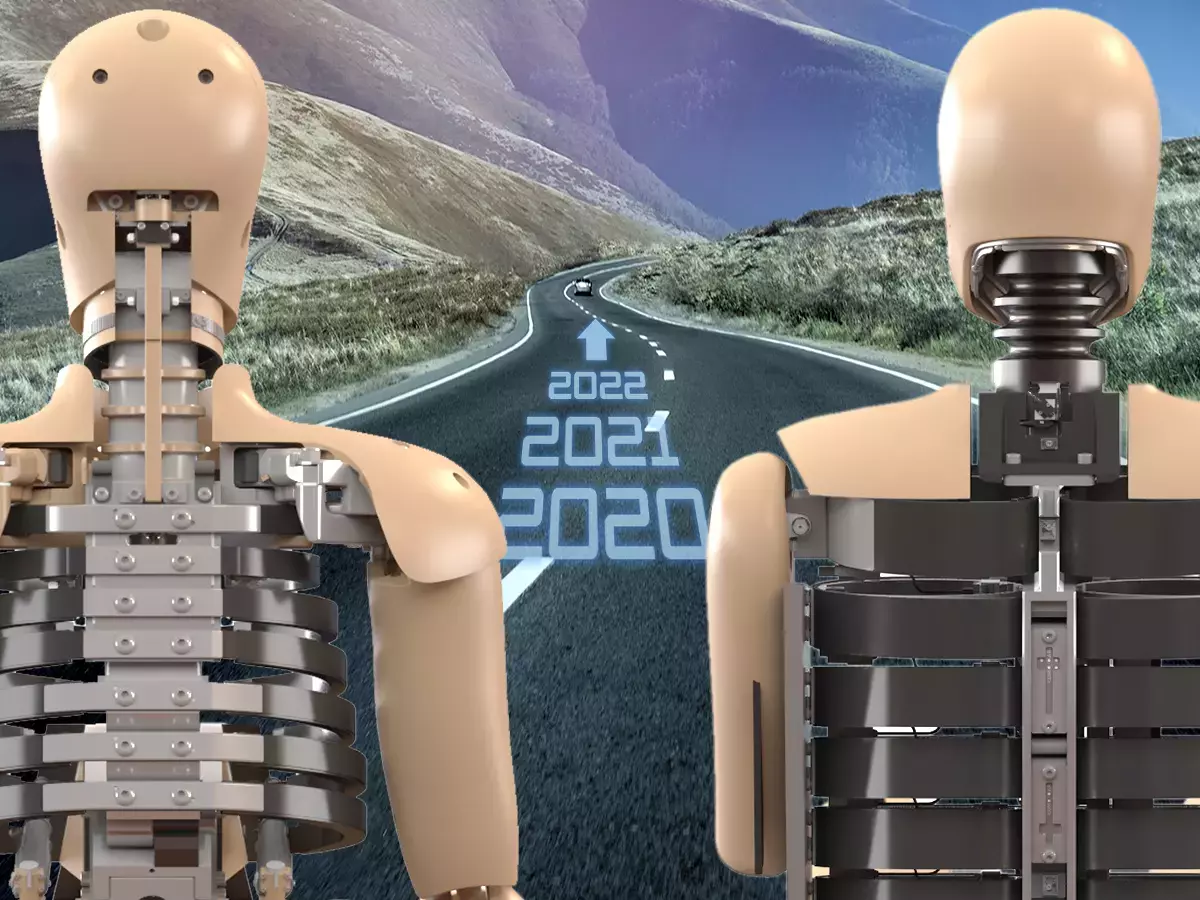What Will New NHTSA Regulated Dummies Mean for Automotive Safety?
In today’s world it seems like everything moves quickly, whether it’s technology, your children growing up, or unfortunately even a virus speeding its way around the globe. And as time moves inexorably forward, it will usher in more changes likely to disrupt the norms we’ve all gotten accustomed to. But rest assured - in the case of our mission for improved automotive safety, that’s definitely a good thing!
What is our National Highway Traffic Safety Administration doing with crash testing in 2020?
If you haven’t heard by now, in July 2020 NHTSA announced some new additions to their regulatory agenda with timing goals for rulemaking. These include actions to issue Notice of Proposed Rulemakings (NPRMs) to certify and define the THOR-50M (Test device for Human Occupant Restraint) and the WorldSID-50M for the Code of Federal Regulations, 49 CFR part 572, by September and November of 2020. Part 572 defines anthropomorphic test devices (ATDs) for use in the U.S. Federal Motor Vehicle Safety Standards (FMVSS) automotive crash testing evaluations.

How will THOR and WorldSID affect FMVSS, and what about the US NCAP?
As you may remember, back in 2015 NHTSA issued a new proposal for revamping and revitalizing its New Car Assessment Program (NCAP). The NCAP program assigns star ratings to all new automotive models released for public sale in the U.S. Just browse through any new car sales lot and take a look at the window stickers. There you’ll find several different classes of star ratings for categories like frontal and side impact test results. NHTSA planned to update their testing procedures with the newer THOR, WorldSID, and pedestrian tools that have been in development for years. Great idea: better assessments, better tools, provisions for active safety systems - what’s not to like? So, here’s where the sometimes-overlooked details matter and come into play. All of the test dummies and devices used in any federal testing scheme, whether it be FMVSS (minimum regulated safety standards) or NCAP (more aggressive rating program), are defined in the government’s Code of Federal Regulations (CFR). But the THOR and WorldSID have yet to be defined in the CFR. Certainly, this is a problem if automotive OEMs and Tier 1 suppliers duplicate the NCAP testing and everyone uses different variations of these dummies that have been produced over the last 10 years.
To maintain consistency, NHTSA must define the ATDs and tools used for their testing by incorporating them into CFR 49, Part 572, the place where our test dummies live. 572 applies strict parameters on how they are built and how they must perform in certification tests before being installed into cars for impact testing. Once a test dummy has permanent residence in Part 572, they can then be used in the appropriate federal test protocols like FMVSS 208 (Frontal impacts), FMVSS 214 (Side Impacts) and NCAP.
What will this NPRM do for the current lineup of Humanetics ATDs?
The Hybrid III dummy family has been the standard workhorse tool for decades in the U.S. crash testing evaluations as well as every other federal and NCAP protocol around the world. The Hybrid III 50th was federalized into Part 572 in 1985 followed by the DOT SID, the 5th female over a decade later, and then of course the Hybrid III children. These newer Hybrid IIIs updated the Hybrid II family, which had been in use since the previous decade. In 2006 NHTSA added the EuroSID-2re to replace the SID-HIII and DOT SID for side impact testing.
With NHTSA adding the THOR and WorldSID ATDs to their regulatory agenda for 2020, it signals their intent to make these dummies the new standard testing tools and replace the aging Hybrid IIIs. The truth is that this makes perfect sense, since these new advanced ATDs can provide two to three times the data collection channels with more human-like sensitivity than the generally stiffer, older generation of dummies.
So, how do these NPRMs work? In a nutshell, when a NHTSA NPRM is issued, there is a public comment period (generally a month or two) for any citizen or business stakeholder to voice their thoughts, opinions, or concerns regarding the intent of the notice. If there is no compelling public objection, NHTSA will issue a Final Rule and mandate an effective date.
Once the THOR and WorldSID are officially in Part 572 via Final Rule, they can be legally incorporated in FMVSS or NCAP testing. Once incorporated into these programs, automakers who sell vehicles in the U.S. must duplicate the new test protocols with these new dummies into their own self-certifying testing programs.
FMVSS vs. US NCAP
In 1966, President Lyndon Johnson signed the legislation that created the federal agency that is known today as NHTSA to regulate automotive safety. This led to the creation of the comprehensive FMVSS standards regulating vehicle design, construction and performance. The FMVSS standards are a minimum set of specifications a car manufacturer must meet to sell vehicles in the U.S. It should be noted that manufacturers often exceed these minimum standards in their efforts to enhance safety.
In 1979 along came the US NCAP, established by NHTSA. Their goal was to push and encourage automakers to build even safer vehicles by using more aggressive testing than used in the FMVSS standards and then reporting the results to the public using the star rating system. The theory holds that the market will force manufacturers to strive for the highest possible ratings to ensure buyers they are purchasing the safest vehicles possible.
Now, here’s the great thing about the NCAP tests: say you only want to run either a frontal FMVSS test or a frontal NCAP test using the new advanced dummies. Wouldn’t you choose the more aggressive NCAP test and be confident that if those results are good, you’ll automatically know you’d pass the minimum FMVSS test without having to actually perform it?
So, what does this NHTSA Announcement really signal?
NHTSA has been criticized in recent years for once being a global leader in advancing crash test safety, only to become a dormant follower to the more aggressive safety advocates from regions like Europe and Asia. Is this criticism warranted? Maybe in some ways, but as we know in the ATD development business, it can take a decade or more to produce a new dummy that is fit to be the next level testing tool. They require years of prototyping and analysis to work out the kinks and behave in the correct biofidelic way to even be considered as a replacement for a tried-and-true test dummy like the Hybrid III 50th that’s been in service for 30 years.
Rushing a complete makeover of the U.S. crash testing landscape is understandably not what NHTSA wants to do, but we’ve all come to the realization that the rapid advancement in automotive safety technology has created the need for improved crash testing analysis. The newer dummies offer more intricate human representation and the ability to provide significantly more data than their older counterparts. There’s a momentum in using these new dummies which cannot be ignored, and NHTSA is well aware of the urgency.
What will the next couple of years look like?
If the ATD NPRMs are issued by the end of 2020 and the dummies incorporated into Part 572 in 2021, this will pave the way for THOR and WorldSID to formally be used in the US NCAP and also allow them to be used almost immediately as a compliance option in FMVSS 208 and FMVSS 214 certification testing. There’s usually a standard ‘phase-in’ period when new dummies are introduced, allowing the old and new to be used simultaneously until the set final effective date, after which only the new ATDs can be used.
These new entries into Part 572 will clear the path for the US NCAP to proceed with their plans to update their protocols as well. With well-defined ATDs, the reproducibility of these more aggressive tests can be assured worldwide.
The THOR and WorldSID dummies are important tools for the Crash Test Industry, both in the U.S. and globally. Currently there are over 200 Humanetics THORs in the field, and over 250 WorldSIDs that are working hard to usher in the next level of safety standards.

Mark Brown
Mark is the Product Marketing Manager at Humanetics Safety and works closely with Engineering and Sales to develop and refine content that is both useful and informative for our industry. With over two decades of experience in crash test dummy product Quality, Technical, Sales, and Marketing, Mark produces a wide range of media and publications including our service bulletins, webinars, editorial articles, and contributes to our marketing collateral.